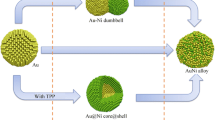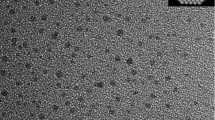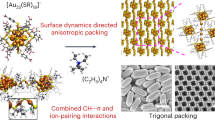Abstract
DNA-mediated synthesis of nanoparticles is a powerful method to access exclusive shapes and surface properties. Previous studies employed seeds containing low-energy facets, such as a simple cubic palladium seed, in the synthesis of Pd-Au bimetallic nanoparticles; however, few studies have investigated whether DNA molecules are influential when a seed containing high-energy facets is used. Seeds enclosed by high-energy facets act as facile nucleation sites in nanoparticle growth and could suppress the effect of DNA. We report the DNA-encoded control of the morphological evolution of bimetallic Pd@Au core-shell nanoparticles from a concave palladium nanocube seed containing high-indexed facets. Based on detailed spectroscopic and microscopic studies of time-dependent growth of bimetallic nanoparticles, we found that the DNA molecules containing 10 repeating units of thymine, guanine, cytosine, or adenine (referred to as T10, G10, C10, and A10, respectively) show a unique interaction with the surface of the seed and the precursor. The most important factor is the binding affinity of the nucleobase to the Pd surface; A10 shows the highest binding affinity and can stabilize the high energy surfaces of the seed. Initially, the growth of bases with lower binding affinities (T10, G10, and C10) is completely dictated by the seed’s surface energy, but later growth can be influenced by different DNA sequences, providing four Pd@Au bimetallic nanoparticles with unique morphologies. The effect of these DNA molecules with medium or low binding affinities can only be observed when more Au is deposited. We propose a scheme for DNA-controlled growth. These results provide insights into the factors governing the DNA-mediated growth of core-shell structures using seeds with high-energy sites, and the insights can be readily applied to other bimetallic systems.

Similar content being viewed by others
References
Tao, A. R.; Habas, S.; Yang, P. D. Shape control of colloidal metal nanocrystals. Small 2008, 4, 310–325.
Xia, Y. N.; Xiong, Y. J.; Lim, B.; Skrabalak, S. E. Shape-controlled synthesis of metal nanocrystals: Simple chemistry meets complex physics? Angew. Chem., Int. Ed. 2009, 48, 60–103.
Tan, L. H.; Xing, H.; Lu, Y. DNA as a powerful tool for morphology control, spatial positioning, and dynamic assembly of nanoparticles. Acc. Chem. Res. 2014, 47, 1881–1890.
Xia, Y. N.; Xia, X. H.; Peng, H. C. Shape-controlled synthesis of colloidal metal nanocrystals: Thermodynamic versus kinetic products. J. Am. Chem. Soc. 2015, 137, 7947–7966.
Barnes, W. L.; Dereux, A.; Ebbesen, T. W. Surface plasmon subwavelength optics. Nature 2003, 424, 824–830.
Hutter, E.; Fendler, J. H. Exploitation of localized surface plasmon resonance. Adv. Mater. 2004, 16, 1685–1706.
Murphy, C. J.; Sau, T. K.; Gole, A. M.; Orendorff, C. J.; Gao, J. X.; Gou, L. F.; Hunyadi, S. E.; Li, T. Anisotropic metal nanoparticles: Synthesis, assembly, and optical applications. J. Phys. Chem. B 2005, 109, 13857–13870.
Lal, S.; Link, S.; Halas, N. J. Nano-optics from sensing to waveguiding. Nat. Photonics 2007, 1, 641–648.
Wang, F.; Han, Y.; Lim, C. S.; Lu, Y. H.; Wang, J.; Xu, J.; Chen, H. Y.; Zhang, C.; Hong, M. H.; Liu, X. G. Simultaneous phase and size control of upconversion nanocrystals through lanthanide doping. Nature 2010, 463, 1061–1065.
Liu, J. B.; Duchesne, P. N.; Yu, M. X.; Jiang, X. Y.; Ning, X. H.; Vinluan, R. D.; Zhang, P.; Zheng, J. Luminescent gold nanoparticles with size-independent emission. Angew. Chem., Int. Ed. 2016, 55, 8894–8898.
Narayanan, R.; El-Sayed, M. A. Catalysis with transition metal nanoparticles in colloidal solution: Nanoparticle shape dependence and stability. J. Phys. Chem. B 2005, 109, 12663–12676.
Astruc, D.; Lu, F.; Aranzaes, J. R. Nanoparticles as recyclable catalysts: The frontier between homogeneous and heterogeneous catalysis. Angew. Chem., Int. Ed. 2005, 44, 7852–7872.
Wei, H.; Lu, Y. Catalysis of gold nanoparticles within lysozyme single crystals. Chem.–Asian J. 2012, 7, 680–683.
Mahmoud, M. A.; Narayanan, R.; El-Sayed, M. A. Enhancing colloidal metallic nanocatalysis: Sharp edges and corners for solid nanoparticles and cage effect for hollow ones. Acc. Chem. Res. 2013, 46, 1795–1805.
Qian, K.; Sweeny, B. C.; Johnston-Peck, A. C.; Niu, W. X.; Graham, J. O.; DuChene, J. S.; Qiu, J. J.; Wang, Y. C.; Engelhard, M. H.; Su, D. et al. Surface plasmon-driven water reduction: Gold nanoparticle size matters. J. Am. Chem. Soc. 2014, 136, 9842–9845.
Wei, D. W.; Sweeny, C. B.; Qiu, J. J.; DuChene, S. J. Metallic nanostructures for catalytic applications. In Metallic Nanostructures: From Controlled Synthesis to Applications. Xiong, Y.; Lu, X., Eds.; Springer International Publishing: Cham, 2015; pp 243–269.
Liu, J. W.; Lu, Y. A colorimetric lead biosensor using DNAzyme-directed assembly of gold nanoparticles. J. Am. Chem. Soc. 2003, 125, 6642–6643.
Rosi, N. L.; Mirkin, C. A. Nanostructures in biodiagnostics. Chem. Rev. 2005, 105, 1547–1562.
Lu, Y.; Liu, J. W. Functional DNA nanotechnology: Emerging applications of DNAzymes and aptamers. Curr. Opin. Biotechnol. 2006, 17, 580–588.
Liu, J. W.; Mazumdar, D.; Lu, Y. A simple and sensitive “dipstick” test in serum based on lateral flow separation of aptamer-linked nanostructures. Angew. Chem., Int. Ed. 2006, 45, 7955–7959.
Lee, K. S.; El-Sayed, M. A. Gold and silver nanoparticles in sensing and imaging: Sensitivity of plasmon response to size, shape, and metal composition. J. Phys. Chem. B 2006, 110, 19220–19225.
Huang, X. H.; El-Sayed, I. H.; Qian, W.; El-Sayed, M. A. Cancer cell imaging and photothermal therapy in the near-infrared region by using gold nanorods. J. Am. Chem. Soc. 2006, 128, 2115–2120.
Wu, P. W.; Hwang, K.; Lan, T.; Lu, Y. A DNAzyme-gold nanoparticle probe for uranyl ion in living cells. J. Am. Chem. Soc. 2013, 135, 5254–5257.
Zhang, J. J.; Cheng, F. F.; Li, J. J.; Zhu, J. J.; Lu, Y. Fluorescent nanoprobes for sensing and imaging of metal ions: Recent advances and future perspectives. Nano Today 2016, 11, 309–329.
Smith, B. R.; Gambhir, S. S. Nanomaterials for in vivo imaging. Chem. Rev. 2017, 117, 901–986.
Jain, P. K.; Lee, K. S.; El-Sayed, I. H.; El-Sayed, M. A. Calculated absorption and scattering properties of gold nanoparticles of different size, shape, and composition: Applications in biological imaging and biomedicine. J. Phys. Chem. B 2006, 110, 7238–7248.
Lu, Y.; Liu, J. W. Smart nanomaterials inspired by biology: Dynamic assembly of error-free nanomaterials in response to multiple chemical and biological stimuli. Acc. Chem. Res. 2007, 40, 315–323.
Jain, P. K.; Huang, X. H.; El-Sayed, I. H.; El-Sayed, M. A. Noble metals on the nanoscale: Optical and photothermal properties and some applications in imaging, sensing, biology, and medicine. Acc. Chem. Res. 2008, 41, 1578–1586.
Dreaden, E. C.; Alkilany, A. M.; Huang, X. H.; Murphy, C. J.; El-Sayed, M. A. The golden age: Gold nanoparticles for biomedicine. Chem. Soc. Rev. 2012, 41, 2740–2779.
Xing, H.; Hwang, K.; Li, J.; Torabi, S. F.; Lu, Y. DNA aptamer technology for personalized medicine. Curr. Opin. Chem. Eng. 2014, 4, 79–87.
Tao, Y.; Li, M. Q.; Ren, J. S.; Qu, X. G. Metal nanoclusters: Novel probes for diagnostic and therapeutic applications. Chem. Soc. Rev. 2015, 44, 8636–8663.
Yu, M. X.; Zheng, J. Clearance pathways and tumor targeting of imaging nanoparticles. ACS Nano 2015, 9, 6655–6674.
Wang, W. J.; Satyavolu, N. S. R.; Wu, Z. K.; Zhang, J. R.; Zhu, J. J.; Lu, Y. Near-infrared photothermally activated DNAzyme–gold nanoshells for imaging metal ions in living cells. Angew. Chem., Int. Ed. 2017, 56, 6798–6802.
DuChene, J. S.; Niu, W. X.; Abendroth, J. M.; Sun, Q.; Zhao, W. B.; Huo, F. W.; Wei, W. D. Halide anions as shape-directing agents for obtaining high-quality anisotropic gold nanostructures. Chem. Mater. 2013, 25, 1392–1399.
Ortiz, N.; Skrabalak, S. E. On the dual roles of ligands in the synthesis of colloidal metal nanostructures. Langmuir 2014, 30, 6649–6659.
Mirkin, C. A.; Letsinger, R. L.; Mucic, R. C.; Storhoff, J. J. A DNA-based method for rationally assembling nanoparticles into macroscopic materials. Nature 1996, 382, 607–609.
Zhang, F.; Nangreave, J.; Liu, Y.; Yan, H. Structural DNA nanotechnology: State of the art and future perspective. J. Am. Chem. Soc. 2014, 136, 11198–11211.
Torabi, S. F.; Lu, Y. Functional DNA nanomaterials for sensing and imaging in living cells. Curr. Opin. Biotechnol. 2014, 28, 88–95.
Li, Y. L.; Liu, Z. Y.; Yu, G. M.; Jiang, W.; Mao, C. D. Self-assembly of molecule-like nanoparticle clusters directed by DNA nanocages. J. Am. Chem. Soc. 2015, 137, 4320–4323.
Liu, Z. Y.; Tian, C.; Yu, J. W.; Li, Y. L.; Jiang, W.; Mao, C. D. Self-assembly of responsive multilayered DNA nanocages. J. Am. Chem. Soc. 2015, 137, 1730–1733.
Veneziano, R.; Ratanalert, S.; Zhang, K. M.; Zhang, F.; Yan, H.; Chiu, W.; Bathe, M. Designer nanoscale DNA assemblies programmed from the top down. Science 2016, 352, 1534–1534.
Wu, X. L.; Xu, L. G.; Ma, W.; Liu, L. Q.; Kuang, H.; Kotov, N. A.; Xu, C. L. Propeller-like nanorod-upconversion nanoparticle assemblies with intense chiroptical activity and luminescence enhancement in aqueous phase. Adv. Mater. 2016, 28, 5907–5915.
Wang, Z. D.; Zhang, J. Q.; Ekman, J. M.; Kenis, P. J. A.; Lu, Y. DNA-mediated control of metal nanoparticle shape: One-pot synthesis and cellular uptake of highly stable and functional gold nanoflowers. Nano Lett. 2010, 10, 1886–1891.
Wang, Z. D.; Tang, L. H.; Tan, L. H.; Li, J. H.; Lu, Y. Discovery of the DNA “genetic code” for abiological gold nanoparticle morphologies. Angew. Chem., Int. Ed. 2012, 51, 9078–9082.
Wu, J. J. X.; Tan, L. H.; Hwang, K.; Xing, H.; Wu, P. W.; Li, W.; Lu, Y. DNA sequence-dependent morphological evolution of silver nanoparticles and their optical and hybridization properties. J. Am. Chem. Soc. 2014, 136, 15195–15202.
Song, T. J.; Tang, L. H.; Tan, L. H.; Wang, X. J.; Satyavolu, N. S. R.; Xing, H.; Wang, Z. D.; Li, J. H.; Liang, H. J.; Lu, Y. DNA-encoded tuning of geometric and plasmonic properties of nanoparticles growing from gold nanorod seeds. Angew. Chem., Int. Ed. 2015, 54, 8114–8118.
Tan, L. H.; Yue, Y.; Satyavolu, N. S. R.; Ali, A. S.; Wang, Z. D.; Wu, Y. Q.; Lu, Y. Mechanistic insight into DNA-guided control of nanoparticle morphologies. J. Am. Chem. Soc. 2015, 137, 14456–14464.
Satyavolu, N. S. R.; Tan, L. H.; Lu, Y. DNA-mediated morphological control of Pd–Au bimetallic nanoparticles. J. Am. Chem. Soc. 2016, 138, 16542–16548.
Li, J. X.; Zhu, Z.; Liu, F.; Zhu, B. Q.; Ma, Y. L.; Yan, J. M.; Lin, B. Q.; Ke, G. L.; Liu, R. D.; Zhou, L. J. et al. DNA-mediated morphological control of silver nanoparticles. Small 2016, 12, 5449–5487.
Laskar, M.; Skrabalak, S. E. Decoupling the geometric parameters of shape-controlled Pd nanocatalysts. ACS Catal. 2014, 4, 1120–1128.
Niu, W. X.; Zhang, W. Q.; Firdoz, S.; Lu, X. M. Controlled synthesis of palladium concave nanocubes with sub-10-nanometer edges and corners for tunable plasmonic property. Chem. Mater. 2014, 26, 2180–2186.
Jin, M. S.; Zhang, H.; Xie, Z. X.; Xia, Y. N. Palladium concave nanocubes with high-index facets and their enhanced catalytic properties. Angew. Chem., Int. Ed. 2011, 50, 7850–7854.
Yu, Y.; Zhang, Q. B.; Xie, J. P.; Lee, J. Y. Engineering the architectural diversity of heterogeneous metallic nanocrystals. Nat. Commun. 2013, 4, 1454.
Sabir, T. S.; Yan, D.; Milligan, J. R.; Aruni, A. W.; Nick, K. E.; Ramon, R. H.; Hughes, J. A.; Chen, Q.; Kurti, R. S.; Perry, C. C. Kinetics of gold nanoparticle formation facilitated by triblock copolymers. J. Phys. Chem. C 2012, 116, 4431–4441.
Han, L.; Maye, M. M.; Leibowitz, F. L.; Ly, N. K.; Zhong, C.-J. Quartz-crystal microbalance and spectrophotometric assessments of inter-core and inter-shell reactivities in nanoparticle thin film formation and growth. J. Mater. Chem. 2001, 11, 1258–1264.
Richards, V. N.; Rath, N. P.; Buhro, W. E. Pathway from a molecular precursor to silver nanoparticles: The prominent role of aggregative growth. Chem. Mater. 2010, 22, 3556–3567.
Njoki, P. N.; Luo, J.; Kamundi, M. M.; Lim, S.; Zhong, C. J. Aggregative growth in the size-controlled growth of monodispersed gold nanoparticles. Langmuir 2010, 26, 13622–13629.
Thanh, N. T. K.; Maclean, N.; Mahiddine, S. Mechanisms of nucleation and growth of nanoparticles in solution. Chem. Rev. 2014, 114, 7610–7630.
Harada, M.; Kizaki, S. Formation mechanism of gold nanoparticles synthesized by photoreduction in aqueous ethanol solutions of polymers using in situ quick scanning X-ray absorption fine structure and small-angle X-ray scattering. Cryst. Growth Des. 2016, 16, 1200–1212.
Zhao, L. L.; Ji, X. H.; Sun, X. J.; Li, J.; Yang, W. S.; Peng, X. G. Formation and stability of gold nanoflowers by the seeding approach: The effect of intraparticle ripening. J. Phys. Chem. C 2009, 113, 16645–16651.
Cao, G. Z. Characterization and properties of nanomaterials. In Nanostructures and Nanomaterials: Synthesis, Properties and Application. Cao, G. Z., Ed.; World Scientific: London, 2011; pp 433–508.
Chen, A. N.; Scanlan, M. M.; Skrabalak, S. E. Surface passivation and supersaturation: Strategies for regioselective deposition in seeded syntheses. ACS Nano 2017, 11, 12624–12631.
Xia, X. H.; Xie, S. F.; Liu, M. C.; Peng, H. C.; Lu, N.; Wang, J. G.; Kim, M. J.; Xia, Y. N. On the role of surface diffusion in determining the shape or morphology of noble-metal nanocrystals. Proc. Natl. Acad. Sci. USA 2013, 110, 6669–6673.
Liu, J. W. Adsorption of DNA onto gold nanoparticles and graphene oxide: Surface science and applications. Phys. Chem. Chem. Phys. 2012, 14, 10485–10496.
Sanchez-Gaytan, B. L.; Qian, Z. X.; Hastings, S. P.; Reca, M. L.; Fakhraai, Z.; Park, S. J. Controlling the topography and surface plasmon resonance of gold nanoshells by a templated surfactant-assisted seed growth method. J. Phys. Chem. C 2013, 117, 8916–8923.
Quan, Z. W.; Wang, Y. X.; Fang, J. Y. High-index faceted noble metal nanocrystals. Acc. Chem. Res. 2013, 46, 191–202.
Kimura-Suda, H.; Petrovykh, D. Y.; Tarlov, M. J.; Whitman, L. J. Base-dependent competitive adsorption of single-stranded DNA on gold. J. Am. Chem. Soc. 2003, 125, 9014–9015.
DeSantis, C. J.; Skrabalak, S. E. Core values: Elucidating the role of seed structure in the synthesis of symmetrically branched nanocrystals. J. Am. Chem. Soc. 2013, 135, 10–13.
Weiner, R. G.; DeSantis, C. J.; Cardoso, M. B. T.; Skrabalak, S. E. Diffusion and seed shape: Intertwined parameters in the synthesis of branched metal nanostructures. ACS Nano 2014, 8, 8625–8635.
Xia, Y. N.; Gilroy, K. D.; Peng, H. C.; Xia, X. H. Seed-mediated growth of colloidal metal nanocrystals. Angew. Chem., Int. Ed. 2017, 56, 60–95.
Habas, S. E.; Lee, H.; Radmilovic, V.; Somorjai, G. A.; Yang, P. D. Shaping binary metal nanocrystals through epitaxial seeded growth. Nat. Mater. 2007, 6, 692–697.
Yu, Y.; Zhang, Q. B.; Liu, B.; Lee, J. Y. Synthesis of nanocrystals with variable high-index Pd facets through the controlled heteroepitaxial growth of trisoctahedral Au templates. J. Am. Chem. Soc. 2010, 132, 18258–18265.
Wang, F.; Li, C. H.; Sun, L.-D.; Wu, H. S.; Ming, T.; Wang, J. F.; Yu, J. C.; Yan, C.-H. Heteroepitaxial growth of high-index-faceted palladium nanoshells and their catalytic performance. J. Am. Chem. Soc. 2011, 133, 1106–1111.
Jin, H.; Lee, K. W.; Khi, N. T.; An, H.; Park, J.; Baik, H.; Kim, J.; Yang, H.; Lee, K. Rational synthesis of heterostructured M/Pt (M = Ru or Rh) octahedral nanoboxes and octapods and their structure-dependent electrochemical activity toward the oxygen evolution reaction. Small 2015, 11, 4462–4468.
Acknowledgements
We wish to thank the U.S. National Institutes of Health (Nos. GM124316 and MH110975) for financial support. N. S. R. S. would like to thank the Beckman Graduate Fellowship for financial support. The authors thank Prof. Hong Yang, Prof. Kenneth S. Suslick, and Prof. Catherine J. Murphy for their insightful discussions. SEM, TEM, and STEM were carried out at the Federick Seitz Materials Research Laboratory Central Research Facilities, University of Illinois. The authors also thank Dr. Moitree Laskar for suggestions in a synthetic protocol, Dianwen Zhang for help with the confocal Raman microscopy, Kapil Dave for CD measurements, Kevin Harnden for help with data analysis and Vishwas Srivastava for help with HR-TEM and helpful discussions.
Author information
Authors and Affiliations
Corresponding author
Electronic supplementary material
Rights and permissions
About this article
Cite this article
Satyavolu, N.S.R., Pishevaresfahani, N., Tan, L.H. et al. DNA-encoded morphological evolution of bimetallic Pd@Au core-shell nanoparticles from a high-indexed core. Nano Res. 11, 4549–4561 (2018). https://doi.org/10.1007/s12274-018-2035-7
Received:
Revised:
Accepted:
Published:
Issue Date:
DOI: https://doi.org/10.1007/s12274-018-2035-7




